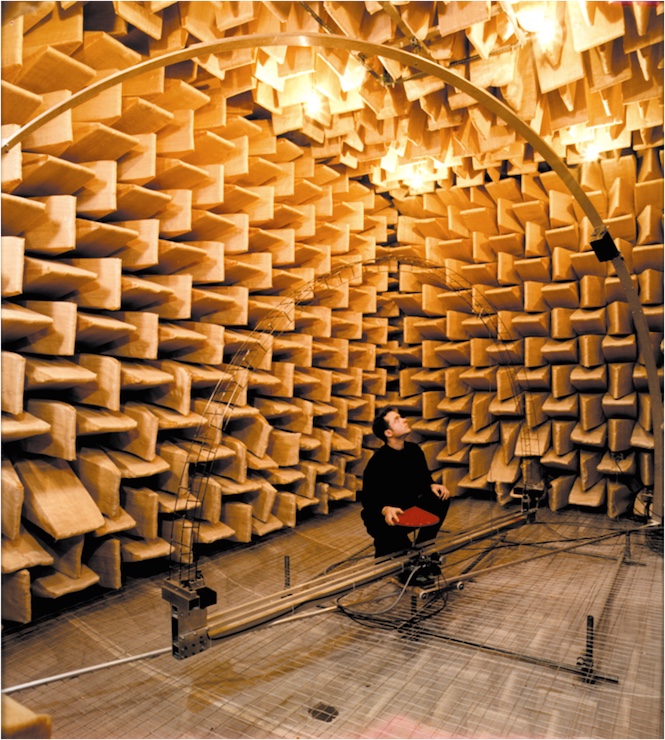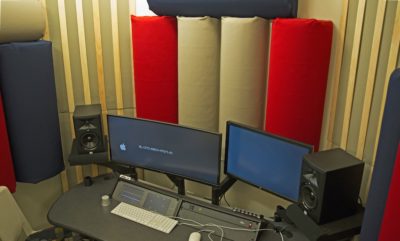Quit Putting it Off and Get Your Acoustics and Monitoring Together

You don’t have to go quite as far as this tech, pictured taking measurements in an anechoic chamber. But a little bit of time and attention spent on your acoustics and monitoring can go further than almost any other upgrade. (Image by Trevor Cox.)
Whenever a musician or fledgling recording engineer decides to create his or her own studio, the journey seems to begin by poring over gear catalogues to choose the sexiest mics, preamps, compressors and EQs.
It’s a common tendency to want to outfit one’s studio with the most glamorous and coveted gear because everyone knows that “this is how you make hit records.”
Shiny new gear is fun to look at, fun to use, and fun to own. I won’t deny that better gear can lead to better recordings, and when I am able to use better equipment, I am usually happier with the results.
(However, it’s also worth noting that bad recordings are made with Neve consoles and Studer tape machines every day.)
Despite this natural urge to focus on gear, the single best thing you can do for your studio is to start with the most important part of the recording chain first: Your monitoring environment. Only then will all that fun-to-use gear really make a difference.
What you hear informs what you choose to do, plain and simple. We rely on our ears to make judgments about timing, tuning, balance, frequency content, emotional impact and so on.
If our perception of the music is impaired in any way, then we will make decisions based on inaccurate information. This can lead to mixes that—at best—don’t translate well to other systems in the outside world or, at worst, are wildly out of balance.
The Real Solution to Your Monitoring Woes
The natural inclination is to assume that the solution to the problem is to buy expensive, high-end monitors.
And sure, there’s no doubt that great monitors are beneficial and can help you work more effectively, but they are only one part of the equation. You also have to take care of the acoustics in your control room to do work that is truly world-class.
While the awareness about the importance of acoustics has been improving in the last 10 years or so, I still think that many recording engineers don’t give acoustics enough attention and priority.
Most engineers don’t have the luxury of working in a control room that is acoustically neutral. If anything, more people probably work in rooms that have little or no acoustic treatment than work in rooms that are anywhere near ideal for the task.
When small studio owners do upgrade, they often select acoustic treatment without real knowledge of what is needed to treat the room properly for their specific use or to address their specific problems. Rather than researching the subject on their own or consulting with an acoustician for technical advice, most people will simply buy panels and bass traps without much regard to how they work, or where they will be most effective in their room.
This leads to many engineers working in rooms that are not ideal, even when they do make efforts to treat them. To deal with this, most engineers establish other reference points from which to work that allow them to work around the shortcomings of the room.
If you’re reading this, it’s likely that you have established some useful “cheats” that can help keep your perspective in check while you’re working, be it listening on the couch at the back of the room, using headphones or earbuds, having multiple sets of monitors to switch between—with each revealing something uniquely important)—and of course, there’s the infamous “car check”.
I am guilty of these kinds of methods myself and have used a variety of them over the years to help me verify that the various elements of my mixes are in balance and are subjectively “correct”. This is particularly pertinent when I work in a studio that I am unfamiliar with, and when working in rooms that are not proper studios at all.
But even when we employ these safeguards, the fact is that we’re not hearing the music as it truly is. While better monitors are almost always better sounding, truer and more accurate, they can’t fight the effects the room has on their response.
In the absence of all acoustic influence, you can do good work on almost (that’s right, I said “almost”) any speaker that is sold as a “studio monitor”. In other words: Money spent on good monitors will only be worth it if you also address the acoustics of the space in which you will use them. Even decent speakers that are placed properly in an acoustically balanced space will still yield good results.
It’s important to understand that there are no acoustically perfect rooms. At the high-end of studio design however, some of these rooms get pretty close.
Experienced studio designers will choose specific room ratios (the numeric relationship between the length width and height of a room) that have good modal distribution. They will take the steps to place the speakers in the optimal position, and then acoustically treat all areas of the room that negatively affect the performance of the monitors.
Acoustics is an extremely complicated subject that can truly only be understood with a lot of time and effort spent studying. I have been a more-than-casual student of acoustics for at least 15 years and realize that I am just scratching the surface of what there really is to know. Every time I think I have something figured out, I find out that I don’t actually understand it as well as I thought I did! Ah well. I use this as inspiration to keep digging.
Why Bother?
Even though mastery of acoustics is hard to come by, understanding even a little bit about the field is beneficial to anyone takes the art of recording seriously.
Acoustics explains the often hard-to-grasp physics behind what happens to sound in a room. Even just beginning to understand why your control room does not sound as good as you may want it to is helpful.
It may inspire you to find real acoustical solutions to fix the room; or at the least will explain why your mixes are consistently suffering from certain “ailments”, and in what areas. Furthermore, understanding the acoustics of the space when placing mics or arranging the musicians in a room will give you better results every time. A decent working knowledge about acoustics should not be exclusive to studio designers!
Thankfully there is a wealth of information available to you if you want to explore this difficult topic:
F. Alton Everest’s book The Master Handbook of Acoustics became my go-to reference a long time ago, and is still probably the most comprehensive book on the subject. I still use this book, even as I learn things elsewhere.
If you are looking to build some of your own treatments or are ambitious enough to actually build a new studio or control room, then Rod Gervais’ Home Recording Studio: Build It Like the Pros is invaluable.
And of course, the internet is full of some excellent information about acoustics, if you look in the right places.
There are two excellent forums about acoustics in recording studios that have been a remarkably instructional for me. The first is the John Sayers Recording Studio Design Forum, which covers everything from design, construction and acoustics, to electrical and wiring. There are a many members who are professionals in the field who seem happy to offer advice. I’ve learned so much from this forum.
The other is the Pro Recording Workshop acoustics forum, which is moderated by a true titan of the acoustics profession, Thomas Jouanjean of Northward Acoustics. The advantage of these forums is that you can learn about things that are usually only available to those with deep pockets. Even if it doesn’t apply to your situation directly, there is still much to be learned from reading and participating.
Some manufacturers of acoustic products are also happy to consult if you are going to purchase their products. Even though they have a vested interest in you buying what they’re selling, the information they give you is largely empirical and unbiased.
GIK Acoustics has a number of articles and tutorials on their website about all sorts of acoustics-related subjects. Auralex offers three different levels of room analysis to help you purchase what you need to optimize your room. Real Traps has long focused on educating studio owners and audiophiles. Primacoustic offers several room kits to deal with the most common issues found in home studio control rooms. And these are just a handful of manufacturers in an increasingly crowded market!

An audio post room the author helped to design for Indiana University, using the principles found in these posts.
A quick web search for “DIY Acoustic Treatments” will come up with countless ways to build your own panels and traps if you’re handy or a bit strapped for cash (or both).
Some of the very best can be found right here on SonicScoop, like:
DIY Studio Design: How To Build Cost-Effective Acoustic Panels
DIY Studio Design (Part 2): How To Build Cost-Effective Bass Traps
And my own DIY Acoustics: Building Your Own Tube Traps
For more general info on overall strategies that you can apply to any studio, try:
Acoustic Treatment for the Small Studio
Soundproofing the Small Studio
How to Build Your Own Soundproof Rehearsal Room (When You Have No Idea What You’re Doing)
The Bottom Line
The thing to take away from all of this is that your ears, your monitors and your room are the system with which you make your musical judgments. If any part of that system is not optimized, then the results will reflect that. If you mix with cotton in your ears then you will not hear the high frequencies clearly. If the room exaggerates the bass response of your speakers, then you’ll never truly know what’s going on down there.
Although it is more common to start by addressing the first two parts of this system by buying good monitors and protecting your hearing (both of which are very important) all of this effort can all be negated if you don’t deal with the acoustics of your room.
An optimized system requires the best performance from each component. When your system is optimized, then you can trust what you hear and react accordingly without second-guessing your decisions. This trust frees you up to be creative and to be certain.
When you know your monitoring environment is trustworthy, then your decisions will also be trustworthy. When you do get it right you will realize that the truth can set your mixes free!
Mike Major is a Mixer/Producer/Recording and Mastering engineer from Dunedin, FL.
He has worked with At The Drive-In, Coheed and Cambria, Sparta, Gone is Gone, As Tall as Lions, and hundreds of other artists over the last 30 years.
Major is the author of the book Recording Drums: The Complete Guide.
Please note: When you buy products through links on this page, we may earn an affiliate commission.







[…] This article can be found on SONICSCOOP.COM […]